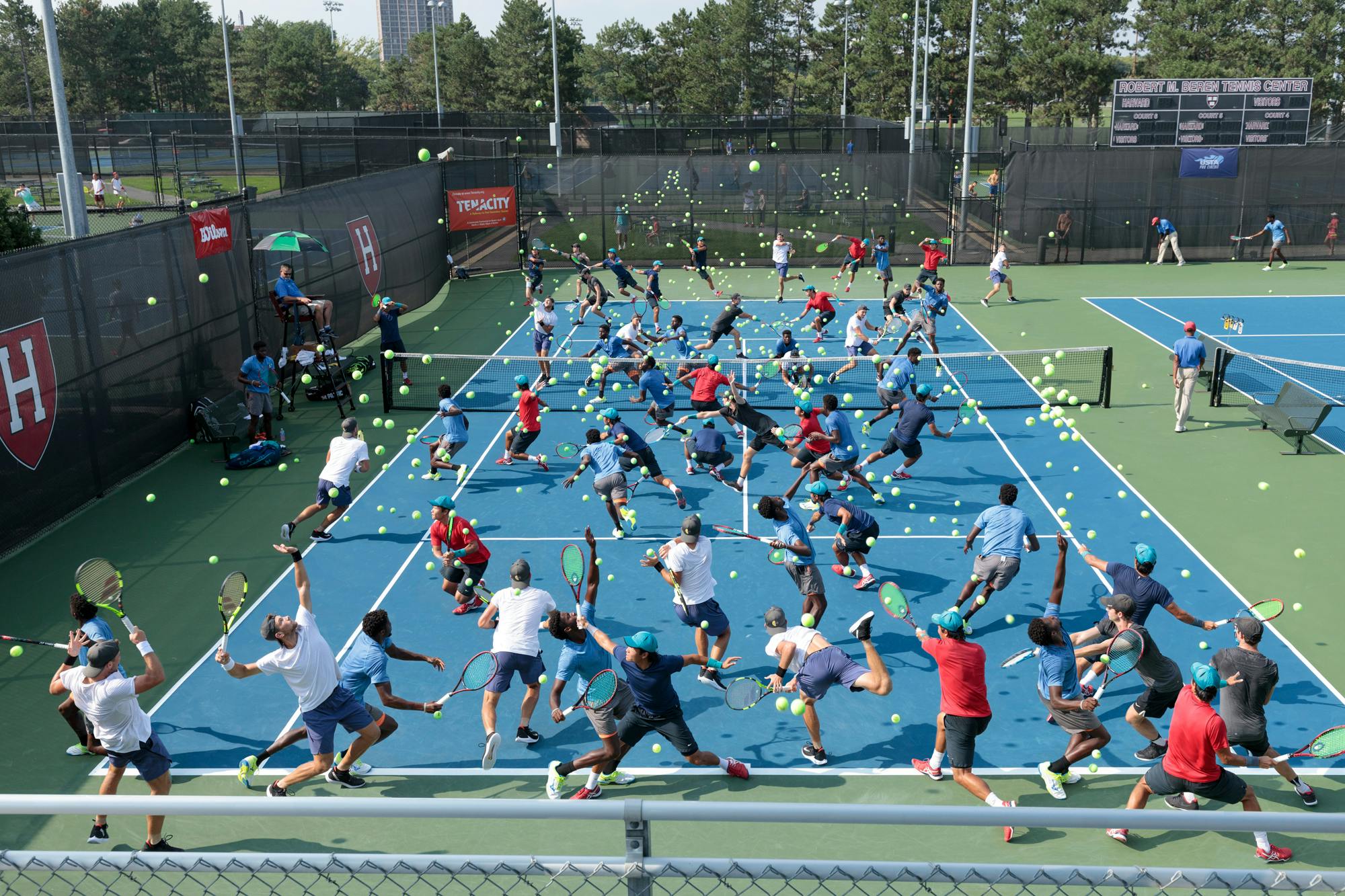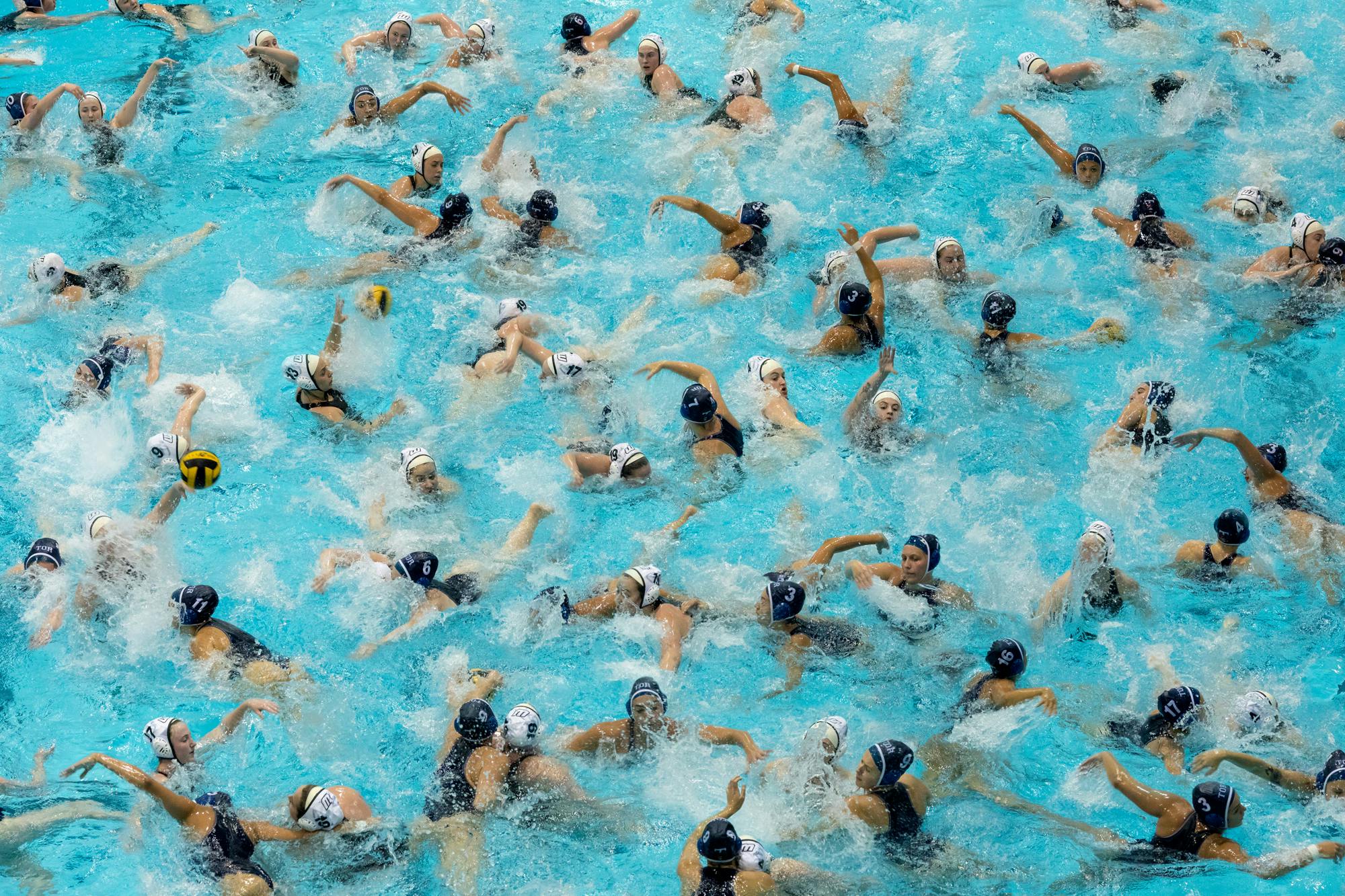Update Feb 23, 2021: Tune into a conversation with Pelle Cass and Annie Armstrong via Abigail Ogilvy Gallery on February 25 at 12:30 PM EST.
I have always hated sports. I’d cry and moan on my way to soccer practice as a kid, high school baseball tailgates were only ever fun for the gossip, and my disdain for NFL fans teeters on psychopathic. My most recent brush with the whole scene was going to see a Boston University football game with an ex, which I now think of, two years later, as three hours of my college experience I’ll never get back. I can recall, with eyes glazed over, trying to alchemize my ennui into an ability to speed up time and get the whole charade over with on fast forward. If only I had been able to focus a little harder, maybe what I saw would have looked more like a Pelle Cass photograph. In his series “Crowded Fields”, the Boston-based artist takes the chaos and energy of college sports games and overlaps the action into something organized yet frenzied, sort of like a fish tank with a gun pointed to it, or a playground with the burners set on high. Cass meticulously organizes the action into orchestrated chaos with an implicit punchline—if the image came to life, you could practically hear heads clunking together like coconuts. That’s a game I’d buy tickets to.
The resulting images combine the black humor of Andreas Gursky’s photography with the elegant mayhem of a Jackson Pollock painting. After I spent time looking at them, really looking at them, a football field became a canvas upon which players create a composition. The Harvard swimming pool was a stage for a performance piece. The fluorescent green of soaring tennis balls became a fascinating tool for contrast against a well-worn court. I chatted with Cass over the phone, and he told me his one rule for his photographs: he doesn’t alter any of the action, but rather organizes and layers it. Through that approach, I feel like I could sit and watch a game at BU again—if only for the aesthetic.
Annie Armstrong: You’ve been a photographer for a while. I would think that a lot of the technical side of photography is still what keeps you interested in the medium, because so much of your work comes in editing.
Pelle Cass: When I was a kid, I didn’t have the urge to draw and paint like a lot of artistic kids did. I didn’t do it very much. I was more the geeky engineering doofus that liked to fool around with a camera. Now, doing all the Photoshop work I do really is like work-ing with my hands. I like that. It’s making something from scratch, or from something else, one little bit at a time. So I have that now, but I didn’t really know as a kid. I had the urge to make things, but it really was more gadget-y. It could have been transistor radios, or something else.
AA: How do you edit your images to form the compositions? They look so frenetic but they’re still really clean.
PC: The main rule, really my only rule, is that I don’t change anything, that I leave everything exactly where it was. I omit lots of stuff—there’s a lot of people and things passing by that aren’t in it—but everybody’s in their real spot and that’s sort of why it looks clean.
When I’m actually working on the photos, all these little bits of time that happened in sequence, I feel like I’m in some little secret part of the world, I guess. It’s kind of exciting that I’m seeing something that’s sort of impossible to see with your eyes, impossible to see with cinema, mostly difficult to see. I am scrutinizing every little bit of the arena or every player. It just feels like I’m seeing into the world.
AA: What inspires you at large?
PC: My reflexive answer always used to be Ed Ruscha. But one direct influence on these pictures was Dana Schutz. I saw her show at the ICA in 2017. When I started “Crowded Fields,” I wanted each figure to be distinct and separate from the others. I’ve always liked confusion, and after Schutz’s paintings sunk into my brain, I tried to smush as much as I could together, as in my pole vault and diving photos, for example.
AA: So as far as your work goes, is there a message you want to convey?
PC: It’s just about the nature of time, the way things happen and you don’t notice them and they build up if you do notice them. And the little things, all these little gestures. There’s something about that. More specific to sports itself, I think I’m kind of invert-ing and turning it on its head and making these kind of hyper-organized militaristic events into chaos. Redoing, reordering sports. Because I like sports but I also hate sports.
AA: I generally hate them.
PC: I hate them for the reasons you hate them, no doubt. It’s, like, obnoxious and competitive and militaristic and boring. But I play sports. For some reason I just always liked playing. So I do watch sports and get some pleasure out of it. I kind of wish colleges didn’t have sports teams, and I’m spending all my time at colleges. You know, it just seems like a waste of money.
AA: What sports do you play?
PC: I play tennis these days. I’ve played some basketball, soccer, volleyball.
AA: That’s a lot of sports!
PC: That’s the other truth. I may kind of hate it but I also kind of love it. I definitely love playing sports. That’s always been true, even when I was growing up in hippie days. It was a point of pride not to keep score in a soccer game. That’s the first sport I played. It was a point of pride and nobody whooped when they got a goal. It seems naive to play that kind of game and not keep score, but that was what we did and that’s sort of how I felt about it for a long time.
AA: I’m too proud to play sports, I think.
PC: Yeah, because you want to be good at it.
AA: And I’m not.
PC: What I really like about sports is, when I’m studying all these pictures, and a lot of it is kind of facial expressions I’m drawn to, it looks like a catastrophe; it looks like these people are kind of rushing around in the middle of a volcano or something, or an earthquake. And I kind of really like that. The human side of sports is that everyone is behaving in what is basically a panic and trying to remain calm. And I really like that!
AA: Yeah, there’s something funny to me about sore losers for a game where there’s no real stakes. Your images are funny to me.
PC: It is funny! It’s a little terrifying. They’re simulating these kind of disasters, but yeah, I’m making fun of it. I like to claim to be profound whenever I can, whenever I have the opportunity, but it’s funny. But I do like that you see a lot of emotions on people’s faces. They tend to be the same sort of emotions—you know, they laugh and cry, but it’s mostly struggle.
AA: It’s very animalistic. People have instinctive, primal facial expressions. A lot of sports photography shows these intense faces that are just never made at any other time in our lives.
PC: Yeah, I think you’re right, because when you’re playing sports it’s a funny state where you’re actually trying to control everything. I think it’s probably true for everyone who plays sports that you’re on the brink of being out of control all the time because you want to do it the best you can. You want to do it the fastest you can, the hardest… So you’re basically on the brink of chaos all the time. I think that’s what people’s expressions are showing.
AA: Maybe I should get back into sports. That sounds kind of nice. I like to be on the brink of chaos.
PC: And that’s what I like about it! When you’re playing the sport, you’re almost blind. You feel like everything is kind of swarming around you. It’s chaos and you have no time. You can’t figure it out, people are coming at you or the ball is coming at you, and it is kind of a fun sort of chaos that you’re trying to make sense of by playing the game properly. I feel guilty when I beat people though. That’s one thing I don’t like.
AA: Come on, not even a little bit?
PC: Okay, a little bit.
Annie Armstrong is an arts writer based in Brooklyn. Her writing has been published in Artsy, The Art Newspaper, New York Magazine, VICE, and ARTnews.
This article was originally published in print for Issue 03: Tracing Movement in Spring 2019. Pelle Cass provided the cover artwork for the issue. Buy it here.




